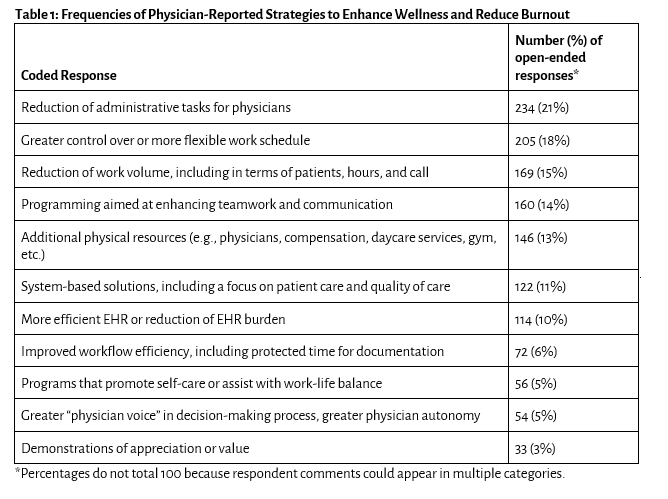Eric Raynal1, Mary Pat Frintner2
1Department of Pediatrics, Indiana University, Indianapolis, Indiana; 2American Academy of Pediatrics, Itasca, IL.
Presented at the 2019 Pediatric Academic Societies Annual Meeting.
Background: Studies have demonstrated that physician burnout is problematic, and attempts have been made to identify predictors of burnout. It is unclear what the most effective strategies are to enhance physician wellness and reduce burnout.
Objective: Assess early- and mid-career pediatricians’ perspectives on strategies that might increase their wellness and reduce burnout.
Methods: Open-ended survey questions from a national study, AAP Pediatrician Life and Career Experience Study were used to collect information on strategies to enhance wellness and reduce burnout in pediatricians’ workplaces. Data were collected in 2017 from a survey sent to 1800 US pediatricians, which included this open-ended question: “If you could improve one aspect of how your workplace provides support for physicians to enhance wellness and reduce burnout, what would it be?” The authors created codes and using a conventional content analysis approach, tagged and assessed all responses. Codes were updated during iterative readings; all coding discrepancies between authors were resolved through discussion.
Results: There were 1137 responses to the open-ended question. Respondents were 74% women and 46% primary care, 38% subspecialty care, 11% hospital care, and 5% other; mean age was 43 years. Coded responses are reported in frequencies (Table 1). Themes most frequently referenced as strategies to enhance wellness were related to workplace structure and processes: reduction of administrative tasks, work schedules, and volume of work. One participant commented, “Finding ways to ease documentation, whether it by improved EMR capabilities, use of scribes, or decreased patient volume would reduce the added burden of documenting for hours after completing my office hours for the day.” Another participant responded, “No after-hours computer work expectation. After-hours work should be reading journals, not creating result letters.”
Less commonly mentioned were programs that focus on individual self-care. One participant commented, “Focus less on ‘wellness’ activities, which while sometimes a nice distraction, ultimately do nothing to eliminate the triggers of burnout.”
Conclusion: Early- to mid-career pediatricians’ solutions to enhance wellness and reduce burnout in the workplace vary considerably. In terms of relative magnitude, there is a clear pattern with more pediatricians recommending solutions that are not individually based interventions but rather strategies to transform the work setting.
